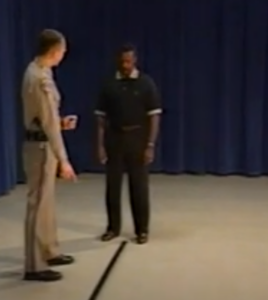The “Walk and Turn” Test | DUI Test Administration & Clues
The "Walk and Turn" Test in DUI Cases
The walk-and-turn test is one of the standardized field sobriety tests that we will most likely need to address in the defense of your DUI case. Generally speaking, the walk-and-turn test is one of the easiest tests for us to address. The test may be circumstantial evidence of intoxication, but for most people, the test and the purported clues on the walk-and-turn test mean little – if anything – about intoxication. As you’ll see, the clues are so specific – so “ticky tacky” – that most jurors don’t believe that the clues tell us much about a specific individual’s level of impairment.
Have you been charged with a DUI based on the walk-and-turn test or other field sobriety tests?

If you have been charged with DUI based upon an officer’s observations of you during the walk-and-turn test or other field sobriety tests, consider getting a free consultation and case evaluation with a Georgia Board-Certified DUI attorney such as Ben Sessions.
Understanding the Walk-and-Turn Test in DUI Cases
The second standardized field sobriety test is a divided attention test called the Walk and Turn test. Initially, the officer will have you assume a heel to toe position by instructing you to place your left foot on a line and place your right foot on the line with the heel of your right foot against the toe of your left foot. You will be told to keep your arms at your side and not to start the test until instructed to do so. The officer is to demonstrate this instructional stance while he is instructing you, the driver, how to stand. After these instructions are given, you will be asked if you understand the instructions so far.
The officer will tell you after he gives the command to start, you are to take nine steps touching heel to toe, after the ninth step, turn, and then take nine heel to toe steps back. The officer is to demonstrate.
The eight clues the officer will be looking for are: not keeping your balance while listening to instructions, starting the test before you are instructed to begin, not touching your heel to your toe, stepping off the line, stopping while walking, using your arms for balance, making an improper tum, and taking more or fewer than nine steps in either direction.
NHTSA requires a designated straight line and a reasonably dry, hard, level, non-slippery surface for the administration of this test. The officer should make sure that there is adequate room for you to take all nine steps. If you are wearing shoes with heels more than two inches high, you should be given the option of removing your shoes. According to the original research, persons with back or leg problems, middle ear problems, as well as persons over the age of 65 have had difficulty performing this test.
The original research indicated that if you have two or more clues on this test or fail to complete the test, you have a 68% chance of having a BAC in excess of .10.
- If you have four or more clues on the Horizontal Gaze Nystagmus test and two or more clues on the Walk and Tum test, there is an 80% chance of having a BAC in excess of 0.10.
Before these percentages are accepted as accurate, you should know the tests were performed in ideal, well lit indoor conditions. The majority of the people tested were over .15 or under .05, which should have made the arrest decision much easier. The deck was stacked, and the tests were slanted to yield the result desired rather than a true evaluation of the test validity.
The National Highway Traffic Safety Administration’s Protocols for the Administration of the Walk-and-Turn Test
Procedures for Walk-and-Turn Testing
- Instructions Stage: Initial Positioning and Verbal Instructions
For understanding in the performance of this test, have the suspect assume the heel-to-toe stance by giving the following verbal instructions, accompanied by demonstrations:
- “Place your left foot on the line” (real or imaginary). Demonstrate.
- “Place your right foot on the line ahead of the left foot, with heel of right foot against toe of left foot.” Demonstrate.
- “Place your arms down at your sides.” Demonstrate.
- “Maintain this position until I have completed the instructions. Do not start to walk until told to do so.”
- “Do you understand the instructions so far?” (Make sure suspect indicates understanding.)
- Demonstrations and Instructions for the Walking Stage
Explain the test requirements, using the following verbal instructions, accompanied by demonstrations:
- “When I tell you to start, take nine heel-to-toe steps, turn, and take nine heel-to-toe steps back.” (Demonstrate 3 heel-to-toe steps.)
- “When you turn, keep the front foot on the line, and turn by taking a series of small steps with the other foot, like this.” (Demonstrate).
- “While you are walking, keep your arms at your sides, watch your feet at all times, and count your steps out loud.”
- “Once you start walking, don’t stop until you have completed the test.”
- “Do you understand the instructions?” (Make sure suspect understands.)
- “Begin, and count your first step from the heel-to-toe position as ‘One.’”
Test Interpretation
What are the 8 clues on the walk-and-turn test in DUI cases?
These are the 8 clues that officers are trained to observe during the administration of the walk-and-turn test in DUI investigations:
- Cannot keep balance while listening to the instructions. Record this clue if the suspect does not maintain the heel-to-toe position throughout the instructions. (Feet must actually break apart.) Do not record this clue if the suspect sways or uses the arms to balance but maintains the heel-to-toe position.
- Starts before the instructions are finished. The impaired person may also keep balance, but not listen to the instructions. Since you specifically instructed the suspect not to start walking “until I tell you to begin,” record this clue if the suspect does not wait.
- Stops while walking. The suspect pauses for several seconds. Do not record this clue if the suspect is merely walking slowly.
- Does not touch heel-to-toe. The suspect leaves a space of more than one-half inch between the heel and toe on any step.
- Steps of the line. The suspects steps so that one foot is entirely off the line.
- Uses arms to balance. The suspect raises one or both arms more than 6 inches from the sides in order to maintain balance.
- Improper turn. The suspect removes the front foot from the line while turning. Also record this clue if the suspect has not followed directions as demonstrated, i.e., spins or pivots around.
- Incorrect number of steps. Record this clue if the suspect takes more or fewer than nine steps in either direction.
Committed DUI Defense Lawyers
Our firm is committed to providing the very highest level of representation for people charged with DUI in Georgia. Our lawyers understand the pseudo-science behind field sobriety tests, including the walk-and-turn turn test, and we understand how to challenge these pieces of evidence. We regularly defend clients charged with DUI in the following areas:

